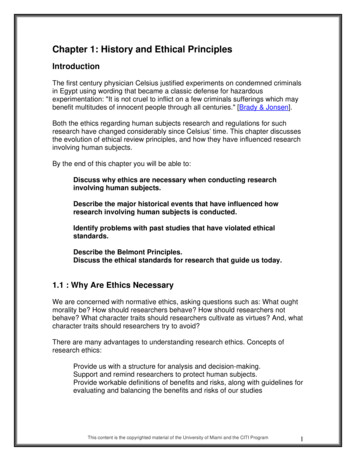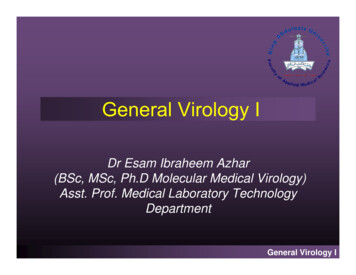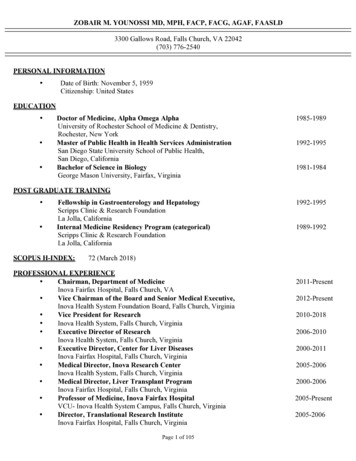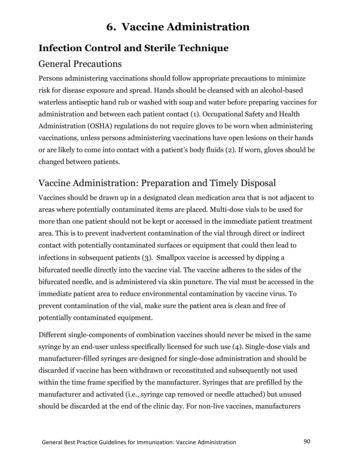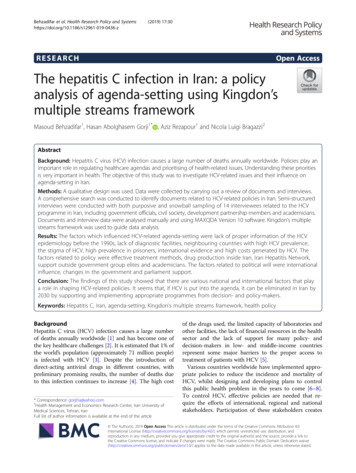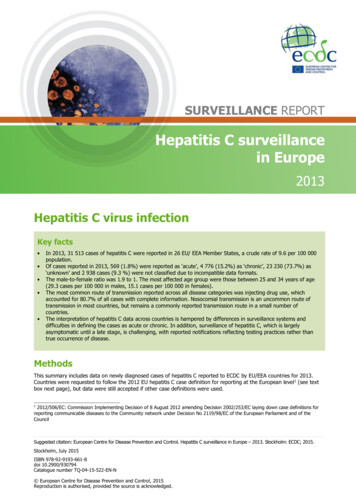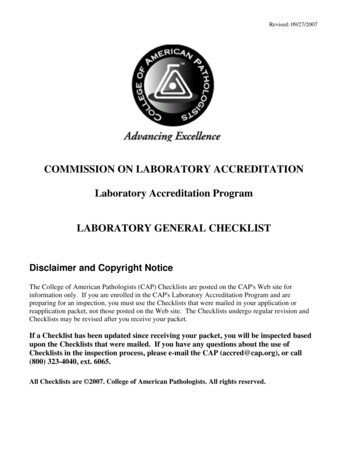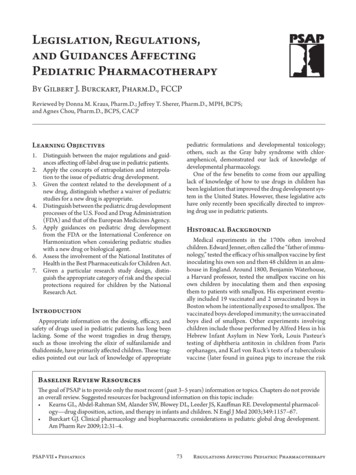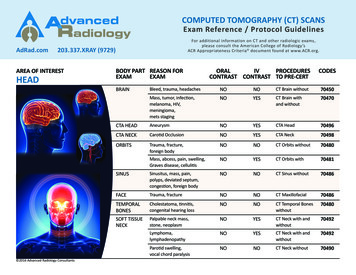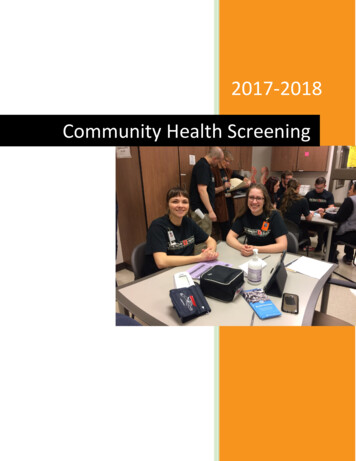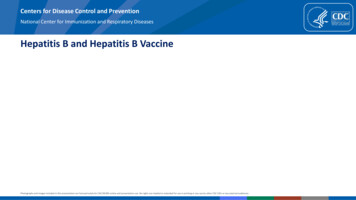
Transcription
Centers for Disease Control and PreventionNational Center for Immunization and Respiratory DiseasesHepatitis B and Hepatitis B VaccinePhotographs and images included in this presentation are licensed solely for CDC/NCIRD online and presentation use. No rights are implied or extended for use in printing or any use by other CDC CIOs or any external audiences.
1Disease
Hepatitis B Virus Hepadnaviridae family (DNA) Numerous antigenic components May retain infectivity for more than7 days at room temperature
Hepatitis B Virus InfectionCauses257 million50%chronic infectionsworldwideof hepatocellularcarcinomas850,000–2.2 millionUS /bfaq.htm#bFAQb04786,000deathsworldwide
Hepatitis B Epidemiology ReservoirHuman Transmissionpercutaneous (i.e., puncturethrough the skin) or mucosal contactwith infectious blood or body fluids(e.g., semen, saliva) Communicability1-2 months before and after onsetof symptomsPersons with either acute or chronicHBV infection with HBsAg present inblood
Hepatitis B Clinical Features Incubation period 60-150 days (average 90 days) Nonspecific prodrome of malaise, fever, headache, myalgia Children 5 years and newly infected immunosuppressed adultsgenerally asymptomatic 30%–50% of persons aged 5 years have signs and symptoms
Hepatitis B Complications Fulminant hepatitis ( 1%) Hospitalization Cirrhosis Hepatocellular carcinoma Death
Risk Factors for Hepatitis B Injection drug use 2 or more sexual partners Men who have sex with men Household contacts of personswith HBV Developmentally disabledpersons in long-term-carefacilities Correctional facilities Persons at risk for occupationalexposure to HBV Hemodialysis patients Persons with HCV infection Persons with chronic liver disease Travelers to countries where HBVis endemic Persons with HIV Persons with Diabetes
Chronic Hepatitis B Virus Infection 80-90% of persons infected during infancy 30% of persons infected before age 6 years 1-12% of persons infected as an older child or adult Approximately 25% of persons chronically infected duringchildhood and 15% chronically infected after childhood will dieprematurely from cirrhosis or liver cancer
Risk of Chronic HBV Infection1008060ChronicInfection risk 40(%)200Birth1-6 mo7-12 moAge of infectionJ Hepatol. 2008;48(2):335-521-4 yrs5 yrs
Chronic Hepatitis B Virus Infection – 4 Phases Immune tolerant Minimal or no hepatic inflammation or fibrosis Immune active Hepatic inflammation with or without fibrosis Immune inactive Improvement of hepatic inflammation and fibrosis Reactivation Active hepatic inflammation with or without fibrosis
Hepatitis B Perinatal Transmission*HBsAg &HBeAg 70-90%infectedHBsAg only10%infected*in the absence of post exposure prophylaxisUp to 90% ofinfected infantsbecomechronicallyinfected
Strategy to Eliminate Hepatitis B Virus Transmission—United States Prevent perinatal HBV transmission Routine testing of all pregnant women for HBsAgNew!oProphylaxis (HepB vaccine and HBIG) for infants born to HepB surface antigen(HBsAg) positive womenoHBV DNA testing for HBsAg positive women and antiviral therapy if HBV DNA is 200,000 IU/mL Universal vaccination of all infants at birth Routine vaccination of previously unvaccinated children andadolescent ( 19 years of age) Vaccination of adults at risk for HBV 6701a1.htm#B2 down
2Vaccine
Hepatitis B-Containing Vaccine Products*Vaccine productAge indicationsSingle-component vaccinesEngerix-BPediatric formulationAdult formulationBirth–19 years20 years and olderRecombivax HBPediatric formulationAdult formulationHeplisav-BBirth–19 years20 years and older18 years and olderCombination vaccinesPediarix–DTaP, IPV and HepB vaccinesTwinrix–HepA and HepB vaccines6 weeks–6 years18 years and older*ACIP does not state a preference for vaccine product versus another if the patient is eligible for more than 1 product
Recommended Dosage of HepB VaccineChildren: Birth through 19 yearsAdults: 20 years and olderRecombivax HBDose (mcg)Engerix-B*Dose (mcg)Heplisav-BDose (mcg)0.5 mL (5)0.5 mL (10)N/A: 17 yrs0.5 mL (20): 18 yrs1.0 mL (10)1.0 mL (20)0.5 mL (20)*Pediarix contains the pediatric formulation of Engerix-B*Twinrix contains the adult formulation of Engerix-B† Heplisav-B approved for use in persons 18 years of age or older
HepB VaccineRecombivax HBDose e (mcg)Heplisav-BDose (mcg)Recombinant HBsAgRecombinant HBsAgAdjuvantedRecombinant HBsAg95%(Range, 80%–100%)95%(Range, 80%–100%)90%–100%3 doses3 doses2 dosesIMIMIM*Pediarix contains the pediatric formulation of Engerix-B*Twinrix contains the adult formulation of Engerix-B
Combination Vaccines Pediarix DTaP/IPV/HepB Ages: 6 weeks through 6 years Routine schedule: 2, 4, 6 months of age Approved for dose 1, 2, 3 of Hep B (Do NOT use for the birth dose) Twinrix HepA/HepB Ages: 18 years of age and older Routine schedule:3 doses at 0, 1, 6 months, or 0, 7, 21- 30 days and a booster dose at 12 months Each dose of Twinrix contains an adult dose of hepatitis B vaccine A HepB series started with Twinrix can be complete with single antigenHepB vaccine and vice versa
3ClinicalConsiderations
ACIP HepB Vaccine Recommendations: Pediatric Routinely recommended for all children birth through 18 yearsof age Vaccinate previously unvaccinated children and those missingdoses
HepB Schedule: Routine InfantDose Routine AgeDose 1Birth§Dose 21- 2 monthsDose 3 6-18 months*§The birth dose of single-component Hepatitis B vaccine should be administered within 24 hours of birth for medically stable infants weighing 2,000grams born to hepatitis B surface antigen (HBsAg)-negative mothers.*Infants whose mothers are HBsAg or whose HBsAg status is unknown should receive the third dose at 6 months of age An additional dose at 4 months is acceptable if the clinician prefers to use a combination vaccine that contains hepatitis B vaccine
HepB Schedule: Minimum Age and Intervals1DOSEDOSE2DOSE38 weeks4 weeks6 months minimum age16 weeks4-day grace can be applied to minimum age and intervals
Pediarix Schedule ConsiderationsCan be given to infants who received HepB at birth 4 doses*Do NOT use for the birth dose1DOSEBirthEngerix B orRecombivax HB2DOSEDOSE3DOSE42 months4 months6 monthsPediarixPediarixPediarix6 months is the minimumage for the last dose*An additional dose at 4 months is acceptable if the clinician prefers to use a combination vaccine that contains hepatitis B vaccine
Birth Dose Considerations:Babies Weighing 2000 grams or moreHBsAg NEGATIVEmotherHBsAg POSITIVEmotherAdminister HepBvaccine within24 hours of birthAdminister HepBvaccine and HBIG*within 12 hours of birth*Administer HepB vaccine and HBIG in separate limbsHBsAg UNKNOWNmotherAdminister HepBvaccine within 12 hoursof birth and test todetermine mother’sstatus ASAP
Birth Dose Considerations:Babies Weighing Less Than 2000 gramsHBsAg NEGATIVEmotherHBsAg POSITIVEmotherAdminister HepBvaccine at hospitaldischarge or at 1month of ageAdminister HepB vaccineand HBIG* within12 hours of birth*Administer HepB vaccine and HBIG in separate limbsHBsAg UNKNOWNmotherAdminister HepB vaccinewithin 12 hours of birth.Give HBIG, if the mother’sHBsAg status cannot bedetermined within 12 hoursof birth*
Medical Considerations: Treating Infants Whose Motheris Hepatitis B Surface Antigen POSITIVE Administer HepB vaccine and HBIG within 12 hours of birth HepB vaccine and HBIG can be administered at the same time HepB and HBIG are both IM injections Administer in different limbs Complete vaccination series at 6 months of age 1st dose does not count when administered to infants weighing lessthan 2000 grams Test for response after completing a 3-dose series at 9 through12 months of age
Medical Considerations: Treating Infants Whose Mother isHepatitis B Surface Antigen UNKNOWN Infants born to women without HBsAg testing results butother evidence suggests maternal HBV infection exists,administer both HepB and HBIG within 12 hours of birth Test mother for HBsAG status as soon as possible Infants weighing 2000 grams or more: If mother is determined to behepatitis B surface antigen positive give HBIG as soon as possible, butno later than age 7 days Infants weighing less than 2000 grams: If the mother tests positive orHBsAG status can not be determined, administer HBIG within 12 hoursof birth
Serologic Testing and Children Prevaccination serologic testing is: Not indicated before routine vaccination of infants or children Recommended for all persons born in Africa, Asia, the Pacific Islands,and other regions with HBsAg prevalence of 2% or higher Postvaccination serologic testing is: Not routinely recommended following vaccination of infants, children,and adolescents Recommended for infants born to HBsAg women
ACIP HepB Vaccine Recommendations: Adult Vaccination recommended unvaccinated adults at risk forHBV infection and adults requesting protection from HBVinfection Acknowledgement of a specific risk factor not required vaccination
Adults at Risk for HBV Infection Hepatitis C virus infection Chronic liver disease HIV infection Sexual exposure risk* Persons with more than one sex partner during the previous 6 months
Adults at Risk for HBV Infection Current or recent injection drug use Percutaneous or mucosal risk for exposure to blood Incarcerated persons Travel in countries with high or intermediate endemic hepatitis B* Persons with more than one sex partner during the previous 6 months
HepB Schedule: AdultRecombivax HB or Engerix-BDoseRoutineIntervalMinimum IntervalDose 1------Dose 21 monthDose 36 months4 weeks8 weeks and at least 16weeks from Dose 1
Heplisav-B ndicationHeplisav-B package insert. Accessed 4/2018Store in the refrigerator between2 C and 8 C (36 F and 46 F)18 years of age and olderAdminister 2 doses separated by 4 weeksIntramuscular (IM) injection in the deltoidCan be administered at the same clinical visit as othervaccines. Administer in separate injection sites, 1 inchapart (if possible)History of severe allergic reaction (e.g., anaphylaxis) after aprevious dose of any hepatitis B vaccine or to anycomponent of Heplisav-B, including yeast
Additional Heplisav-B Considerations 2-dose HepB series only applies when BOTH doses areHeplisav-B, administered at least 4 weeks apart Any 2 doses of Heplisav-B separated by 4 weeks is considered complete,even if the patient has had other HepB vaccine products Until safety data are available for Heplisav-B, providers shouldvaccinate pregnant women needing HepB vaccination withEngerix-B or Recombivax HBMMWR 2018;(No.15):455–58
Scenarios1.HepBEngerix-B or HepB-CpGHeplislav-B03/01/2018Completed seriesNo additional dosesare needed2.HepBEngerix-B or Completed seriesNo additional dosesare neededHepBEngerix-B or RecombivaxHB05/01/2018
Diabetes Mellitus Compared with adults without diabetes, adults with diabeteshave a 60% higher prevalence of past or present HBV infectionand twice the odds of acquiring acute HBV Possibility of a higher case-fatality proportion among persons withdiabetes acutely infected with HBV ACIP recommends HepB vaccination for persons with diabetesmellitus aged 60 years and persons with diabetes mellitusaged 60 years at the discretion of the treating clinician No preference for any of the available vaccinesMMWR Recomm Rep 2018;67(No. RR-#):[1-31]
Dialysis Hepatitis B vaccination is recommended for susceptiblehemodialysis patients Hepatitis B vaccine is also indicated for patients whose renaldisease is likely to lead to dialysis or transplantationMMWR Recomm Rep 2018;67(No. RR-#):[1-31]
Dialysis For patients undergoing hemodialysis and for otherimmunosuppressed patients, higher vaccine doses orincreased number of doses are required Special formulations of the vaccines are now available for such persons(Recombivax HB, 40 µg/mL, Energix B, 40 µg/mL) If an adult patient begins the vaccine series with a standarddose before beginning hemodialysis treatment, then moves tohemodialysis treatment before completing the series,complete the series using the higher dose recommended forhemodialysis patients
ACIP HepB Vaccine Recommendations: Healthcare and PublicSafety Personnel All healthcare personnel (HCP) whosework-, training-, and volunteer-relatedactivities involve reasonably anticipatedrisk for exposure to blood or body fluidsshould be assessed for evidence ofimmunity to hepatitis B.
Evidence of Immunity for HCP Written documentation of a complete HepB vaccine seriesANDSubsequent documented anti-HBs 10 mIU/mL
Common Clinical Scenarios for HCP Documentation of complete series AND documented positive titer Unvaccinated (or incomplete series) Documentation of complete series but no documented positive titer
Documentation of complete vaccine series AND documentedpositive titer HCP considered immune NO additional serologic testing or vaccine “booster” doses Advise the person to keep a copy of the vaccine record andpositive titer FOREVER
Unvaccinated HCP (or incomplete vaccine series)Positive(anti-HBs 10mIU/mL)VaccinateHCP consideredimmune No further serologictesting or vaccinationrecommendedPost-vaccinationserologic testing(1-2 months afterfinal dose)Negative(anti-HBs 10mIU/mL)Administer a secondcomplete HepBvaccine series Post –vaccinationserologic testing(1-2 months afterfinal dose)
Documentation of complete vaccine series but no documentedpositive titerSerologic testingPositive(anti-HBs 10mIU/mL)HCP consideredimmune No further serologictesting or vaccinationrecommended
Documentation of complete vaccine series but no documentedpositive titer (2)Positive(anti-HBs 10mIU/mL)Serologic testingNegative(anti-HBs 10mIU/mL)HCP consideredimmune No further serologictesting or vaccinationrecommendedAdminister 1 dose ofHepB vaccineFollowed by postvaccination serologictesting(1-2 months later)Negative(anti-HBs 10mIU/mL)Complete secondHepB vaccine series Post –vaccinationserologic testing(1-2 months afterfinal dose)
Persistent Nonresponse to HepB Vaccine Less than 5% of vaccinees do not develop anti-HBs after 6 validdoses May be nonresponder or “hyporesponder” Check HBsAg status If exposed, treat as nonresponder with postexposureprophylaxis
HCP and Postexposure dfs/rr6701-H.pdf
Prevaccination Serologic Testing Recommended for: All persons born in Africa, Asia, the Pacific Islands, and other regionswith HBsAg prevalence of 2% or higher Household, sex, and needle-sharing contacts of HBsAg-positive persons Men who have sex with men Injection drug users Certain persons receiving cytotoxic or immunosuppressive therapy
Postvaccination Serologic Testing Serologic testing is NOT routinely recommended followingvaccination of most persons Recommended for: Chronic hemodialysis patients Other immunocompromised persons Persons with HIV infection Sex partners of HBsAg persons Health care personnel
Revaccination Revaccination is generally not recommended for persons witha normal immune status Recommended for the following: HBsAg-negative infants with anti-HBs 10 mIU/mL (born to HBsAgpositive mothers) Hemodialysis patients HIV-infected persons Other immunocompromised persons
Vaccine Administration Route: IM Injection Needle gauge: 22–25 gauge Needle length*: 5/8 – 1.5 inch depending on the patient’s age and/orweight Site*: Birth–11 months: Vastus lateralis muscle is preferred 1–3 years: Vastus lateralis muscle is preferred; deltoid muscle may beused if the muscle mass is adequate 4 years and older: Deltoid muscle is preferred; vastus lateralis musclemay be used*Professional judgement should be used to determine the proper needle length and site. Factors influencing site including local reaction, number of vaccine to be administered age and muscle mass
Vaccine Administration Considerations Route: IM Injection Administer HepB vaccine and HBIG (if needed) in different limbs Site: NO BUTTS!Administration ErrorsCount the Dose or Revaccinate?Adult formulation administered to a childCount the dose, if it meets minimum age andintervalPediatric formulation administered to anadultDose does not count and should be repeatedASAPHepA instead of HepB vaccineAdminister HepB vaccine ASAP
HepB Vaccine Contraindications and Precautions Contraindication Severe allergic reaction to a vaccine component or following a priordose Precaution Moderate or severe acute illness
HepB Vaccine Adverse ReactionsSymptomPain at injection eadache3%Severe systemic reactionsrare
Hepatitis B Vaccine Storage and Handling Store HepB-containing vaccines in arefrigerator between 2 C - 8 C(36 F 46 F) DO NOT FREEZE Store in the original packaging with thelids closed in a clearly labeled binand/or area of the storage unit Store pediatric and adult formulationsseparately, away from each other andother look- or sound-alike vaccines; e.g.,HepA, Hib, HPVVaccine storage label exampleAvailable at ne-storage-labels.pdf
4Resources
Information for Parents:Hepatitis B and the Vaccine(Shot) to Prevent ItCDC accessed 4/8/2018 d/hepB-basics-color.pdf
Hepatitis B Standing Order TemplatesChildren and AdultsImmunization Action Coalition access 4/8/2018 Children http://www.immunize.org/catg.d/p3076a.pdf Adult http://www.immunize.org/catg.d/p3076.pdf
Ask the Experts–Hepatitis B FAQs:www.immunize.org/askexperts/experts hepb.asp CDC Viral Hepatitis–Hepatitis B Information:www.cdc.gov/hepatitis/hbv/index.htm CDC Hepatitis B ml Hepatitis B and the Vaccine (Shot) to Prevent It–Information forParents: sics-color.pdf
Hepatitis B Facts–Testing and Vaccination:www.immunize.org/catg.d/p2110.pdf Hepatitis B and Health Care Personnel–FAQs:www.immunize.org/catg.d/p2109.pdf Infection Prevention during Blood Glucose Monitoring andInsulin Administration: g.html Preexposure Evaluation for Health Care Personnel PreviouslyVaccinated with Complete 3-Dose HepB Vaccine Series WhoHave Not Had Postvaccination Serologic Testing (Figure f
Jan 01, 2018 · 0, 7, 21- 30 days and a booster dose at 12 months Each dose of Twinrix contains an adult dose of hepatitis B vaccine A HepB series started with Twinrixcan be complete with single antigen Hep
